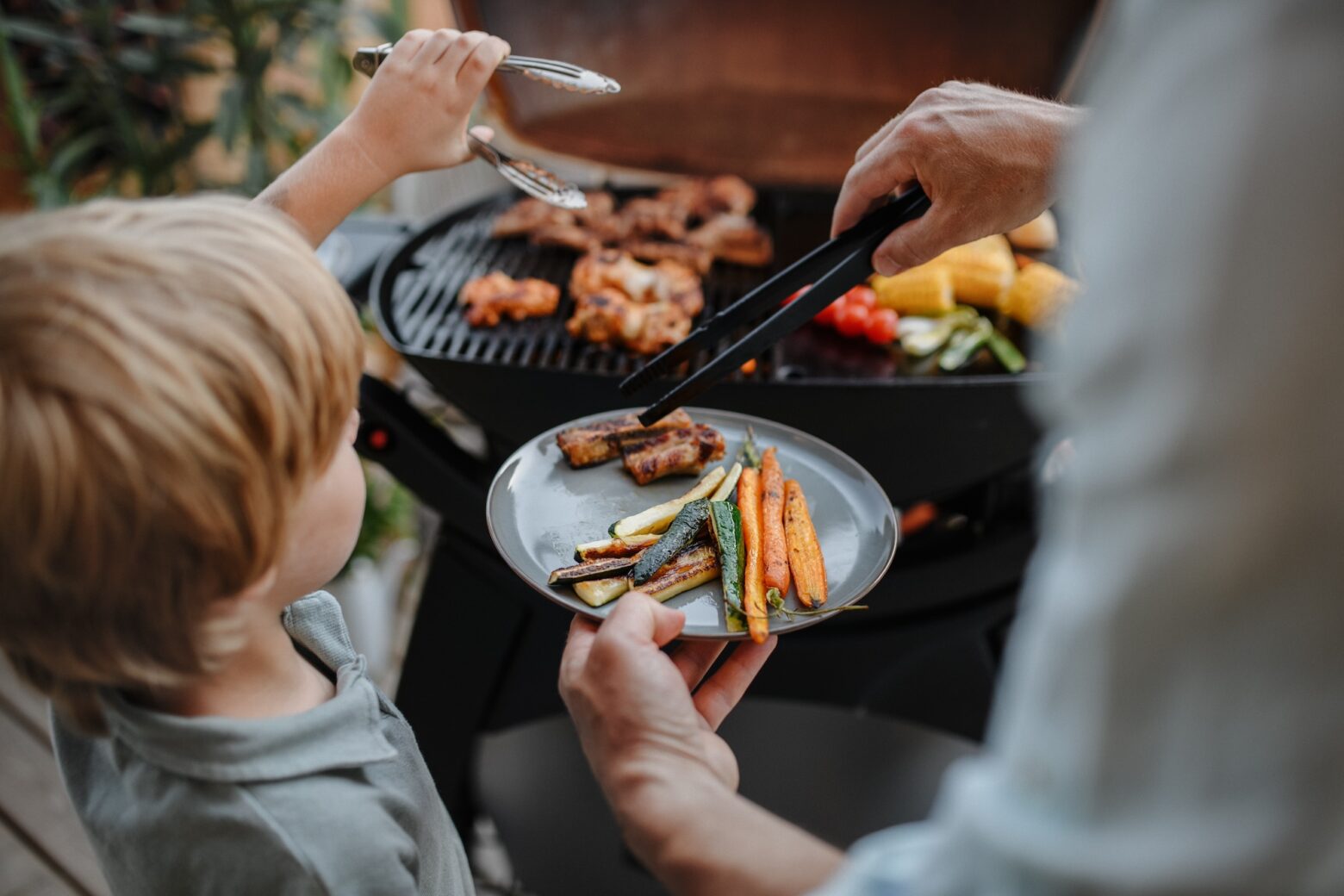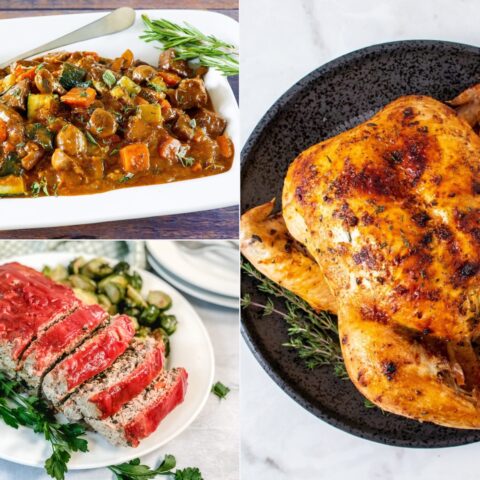Is Grilled Food Healthy?

North Americans love to grill, according to a 2023 report from the Hearth, Patio & Barbecue Association. In the U.S. and Canada, up to 70% of all households own at least a grill or smoker. Fifty-four percent of grill owners cook outdoors on the Fourth of July, the most popular grilling day of the year. Labor Day comes in second (47%), followed by Memorial Day (44%) and Father’s Day (34%). [1]
With all this time spent in front of the grill, it’s important to consider the health implications of a cooking device known for smoking, burning, and charring food. You may be wondering, is grilled food healthy? Which type of grill or fuel source is healthier for you than others? What safety precautions should you be taking for the type of grill you have? To maximize your passion for cooking outdoors, consider the healthiest and safest ways to grill the foods you love.
So Is Grilled Food Healthy?
Cooking with high heat can introduce harmful chemicals into food, such as advanced glycation end products (AGEs) and acrylamides. These pose significant health risks, [2,3] but there’s more to it, especially when looking at fuel sources. It’s not just about the taste; it’s about making informed choices for your health and the environment.
Without argument, propane gas and electric barbecues pose the lowest health risks for grilling because, other than AGEs, the cooking process does not introduce compounds or inputs that might affect human health or air quality. (This discussion does not include the carbon footprint associated with gas, electric, or other grilling fuel sources.)
Concerns arise with the introduction of combustion, compounds in the fuel sources, and how these factors might affect the air and the body.
Charcoal Fuel Emissions vs. Wood Pellets
Recent findings show that commercially produced charcoal briquettes, lump charcoal, or wood pellets present environmental and human health risks depending on the technology, additives used in production, and lighting method.
Charcoal
Commercially produced charcoal, whether in the form of briquettes or lumps, is a popular choice for grilling because of the unique smoky flavors and aromas it gives the food.
Charcoal briquettes are made for recreational cooking by burning wood scraps. The burnt bits, called dust and fines, are combined with a food-grade starch binder, oxidizing agents that make them easy to light, and sometimes lighting accelerants. The material is formed into manageable pieces, dried, and bagged for purchase. Briquettes are designed to cook over low heat for a long time.
Lump charcoal (also made from wood) is pure carbon, typically containing no additives, and is made to burn hotter. Grilling experts like the flavor and use it frequently for grilling with the lid closed, such as rotisserie chicken, wings, pork, or thick cuts of meat.
It’s not a stretch to see how charcoal emits pollutants. Studies show burning charcoal releases emissions of particulate matter (PM), hydrocarbons (HC), carbon monoxide (CO), carbon dioxide (CO2), nitrogen oxides (NOx), and other volatile organic compounds (VOCs). [4] Dripping fats and oils, and water evaporation also contribute to the emissions level.
For human health, all charcoal of any type can increase the risk of developing respiratory illnesses, cardiovascular diseases, and carcinogenic conditions, because the same compounds released from the combustion process and smoke pollute the air.
However, depending on the additives used to make the briquettes, commercially made lump charcoal releases slightly less PM, HC, NOx, and CO than charcoal briquettes. Also, a chimney lighting device makes lighting easier and does not contribute to VOCs as lighter fluid does.
Wood Pellets
Wood pellets, another popular fuel source for grilling, are made by compressing sawdust and wood shavings into small cylindrical shapes using a pellet mill. Depending on the type of wood, when the pellets burn, they impart unique flavor profiles into the food, such as hickory, apple, cherry, mesquite, oak, and maple.
Studies show that grilling with wood pellets also leads to elevated PM, NOx, sulfur dioxide, CO, and CO2 emissions. Depending on the contaminants in the wood, the pellets also emit formaldehyde. Given that there are no standards for food-grade wood pellets, studies suggest that wood pellets can be more harmful to air quality and human health than charcoal briquettes. [5]
Gas Grill Safety Tips
As with any heating element, safety precautions must be taken when cooking on a grill. Because gas grills with portable liquid propane (LP) tanks are so common, we’ve provided some tips for you to stay safe when cooking with propane.
- Pay attention to propane fill levels. By law, LP tanks should only be filled to 80% capacity to allow the gas to expand.
- Store LP tanks outside in a well-ventilated area. Turn the LP cylinder valve off (clockwise) when not in use. Leave the tanks upright and do not store in temperatures above 120°F. Do not store spare tanks near the grill or other appliances.
- Disconnect the LP cylinder only when the grill is turned off and cooled.
- Trade in LP cylinders that are rusted, corroded, dented, or leaking.
- Clean and regularly check the regulator hoses, valves, and air shutters only after turning off the gas source.
- Keep the lid open when igniting the grill to prevent flash flames.
- If the burners go out, turn all the gas valves off. Wait five minutes before relighting.
Grilled Food Can Be Healthy When Cooked Right
When following a healthy lifestyle, you don’t want the nutrients from your food to be counteracted or damaged with the way it’s being cooked. Choose electric or propane when selecting your next grill, and follow all safety precautions with the latter fuel.
You can also keep your grilled food healthy and flavorful by following our Paleo grilling guide, which includes steps for keeping your grill clean. For more inspiration, explore some of our healthy grill recipes below.
References:
- 2023 State of the Barbecue Industry > Hearth, Patio & Barbecue Association (HPBA) [Internet]. www.hpba.org. Available from: https://www.hpba.org/Resources/PressRoom/ID/2259/2023-State-of-the-Barbecue-Industry
- J U, W C, M P, S G, L F, G S, et al. Circulating Glycotoxins and Dietary Advanced Glycation Endproducts: Two Links to Inflammatory Response, Oxidative Stress, and Aging [Internet]. The journals of gerontology. Series A, Biological sciences and medical sciences. 2007. Available from: https://pubmed.ncbi.nlm.nih.gov/17452738/
- National Cancer Institute. Acrylamide and Cancer Risk [Internet]. National Cancer Institute. Cancer.gov; 2017. Available from: https://www.cancer.gov/about-cancer/causes-prevention/risk/diet/acrylamide-fact-sheet
- Mencarelli A, Greco R, Balzan S, Stefano Grigolato, Cavalli R. Charcoal-based products combustion: emission profiles, health exposure, and mitigation strategies. Environmental Advances. 2023 Oct 1;13:100420–0.
- Jelonek Z, Drobniak A, Mastalerz M, Jelonek I. Emissions during grilling with wood pellets and chips. Atmospheric Environment: X. 2021 Dec;12:100140.
Kimberly Lord Stewart
Kimberly Lord Stewart is an author, journalist, and culinary expert. Her work highlights the importance of incorporating whole foods into daily diets and emphasizes the connection between food and overall well-being.
More About The Author



